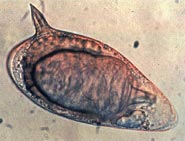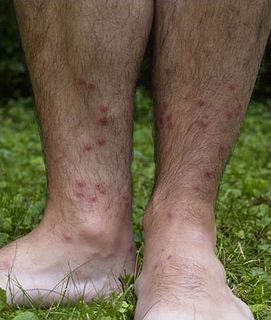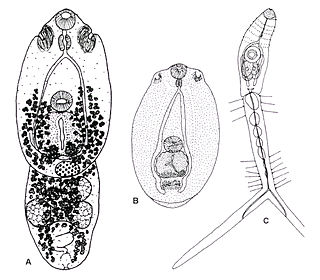
Schistosoma is a genus of trematodes, commonly known as blood flukes. They are parasitic flatworms responsible for a highly significant group of infections in humans termed schistosomiasis, which is considered by the World Health Organization as the second-most socioeconomically devastating parasitic disease, with hundreds of millions infected worldwide.

Digenea is a class of trematodes in the Platyhelminthes phylum, consisting of parasitic flatworms with a syncytial tegument and, usually, two suckers, one ventral and one oral. Adults commonly live within the digestive tract, but occur throughout the organ systems of all classes of vertebrates. Once thought to be related to the Monogenea, it is now recognised that they are closest to the Aspidogastrea and that the Monogenea are more closely allied with the Cestoda. Around 6,000 species have been described to date.

The freshwater crocodile, also known as the Australian freshwater crocodile, Johnstone's crocodile or colloquially as freshie, is a species of crocodile endemic to the northern regions of Australia.

Schistosomatidae is a family of digenetic trematodes with complex parasitic life cycles. Immature developmental stages of schistosomes are found in molluscs and adults occur in vertebrates. The best studied group, the blood flukes of the genus Schistosoma, infect and cause disease in humans. Other genera which are infective to non-human vertebrates can cause mild rashes in humans.

Trematodes are parasitic flatworms of the class Trematoda, specifically parasitic flukes with two suckers: one ventral and the other oral. Trematodes are covered by a tegument, that protects the organism from the environment by providing secretory and absorptive functions.

X-ray microtomography, like tomography and X-ray computed tomography, uses X-rays to create cross-sections of a physical object that can be used to recreate a virtual model without destroying the original object. The prefix micro- is used to indicate that the pixel sizes of the cross-sections are in the micrometre range. These pixel sizes have also resulted in the terms high-resolution X-ray tomography, micro–computed tomography, and similar terms. Sometimes the terms high-resolution CT (HRCT) and micro-CT are differentiated, but in other cases the term high-resolution micro-CT is used. Virtually all tomography today is computed tomography.

Trichobilharzia regenti is a neuropathogenic parasitic flatworm of birds which also causes cercarial dermatitis in humans. The species was originally described in 1998 in the Czech Republic and afterwards it was detected also in other European countries, e.g. Denmark, Germany, France, Iceland, Poland, Switzerland, or Russia, and even in Iran. For its unique neurotropic behaviour in vertebrate hosts, the host-parasite interactions are extensively studied in terms of molecular biology, biochemistry and immunology.

Swimmer's itch, cercarial dermatitis or schistosome dermatitis is a short-term allergic immune reaction occurring in the skin of humans that have been infected by water-borne schistosomes, a type of flatworms. It is common in freshwater, brackish and marine habitats worldwide. Incidence may be on the rise, although this may also be attributed to better monitoring. Nevertheless, the condition has been regarded as emerging infectious disease.

Waterborne diseases are conditions caused by pathogenic micro-organisms that are transmitted in water. These diseases can be spread while bathing, washing, drinking water, or by eating food exposed to contaminated water. While diarrhea and vomiting are the most commonly reported symptoms of waterborne illness, other symptoms can include skin, ear, respiratory, or eye problems. Waterborne diseases are impacted by a country's economy and also impact the economy by being costly to deal with.

The ZW sex-determination system is a chromosomal system that determines the sex of offspring in birds, some fish and crustaceans such as the giant river prawn, some insects, the schistosome family of flatworms, and some reptiles, e.g. majority of snakes, lacertid lizards and monitors including Komodo dragons. It is also used in some plants where it has probably evolved independently on several occasions. The letters Z and W are used to distinguish this system from the XY sex-determination system. In this system, females have a pair of dissimilar ZW chromosomes, and males have two similar ZZ chromosomes.
Schistosoma nasale is a species of digenetic trematode in the family Schistosomatidae. S. nasale inhabits blood vessels of the nasal mucosa and causes "snoring disease" in cattle, but remains symptomless in buffaloes though extruding its eggs in nasal discharge. The first intermediate host is a freshwater snail Indoplanorbis exustus that may be the sole natural intermediate host for Schistosoma nasale on the Indian sub-continent.
Schistosoma indicum is a species of digenetic trematode in the family Schistosomatidae. The parasite is widespread in domestic animals in India and other Asian countries.
Schistosoma ovuncatum is a schistozome parasite, first described in 2002. Its recognition as a new species only occurred when zoologists were re examining specimens originally described in 1984
Griphobilharzia amoena is a significant trematode that infect crocodiles such as the Australian freshwater crocodile, Crocodylus johnstoni, located in Darwin, Australia with reported illness in Irian Jaya as well. They possess a distinctive tegument that is composed of two lipid bilayers instead of a single bilayer. The double bilayer may be an adaptation to survive the host's immune response.
Spirorchiidae is a family of digenetic trematodes. Infestation by these trematodes leads to the disease spirorchiidiosis. Spirorchiids are mainly parasites of turtles. It has been synonymised with Proparorchiidae Ward, 1921, Spirorchidae Stunkard, 1921, and Spirorchiidae MacCallum, 1921.
Acetabulum in invertebrate zoology is a saucer-shaped organ of attachment in some annelid worms and flatworms. It is a specialised sucker for parasitic adaptation in trematodes by which the worms are able to attach on the host. In annelids, it is basically a locomotory organ for attaching to a substratum. The name also applies to the suction appendage on the arms of cephalopod molluscs such as squid, octopus, cuttlefish, Nautilus, etc.

Bivitellobilharzia nairi is a species of trematodes, part of the family Schistosomatidae. It is most closely related to the blood fluke Bivitellobilharzia loxodontae, which uses African forest elephants as a definitive host. Each of these schistosomes, that are part of the genus Bivitellobilharzia, sit near the base of a branch within the schistosome family that contains mammal-infecting species. This is a fairly new identified endoparasite that was found in 1955 by Mudaliar and Ramanujachari, who first recorded the parasite in India. Researchers collected fecal samples of the Indian rhinoceros and were startled to find B. nairi eggs.

Trichobilharzia is a genus of trematodes in the family Schistosomatidae. They are worldwide distributed parasites of anatid birds and causative agents of human cercarial dermatitis.

Diplostomida is an order of trematodes in the subclass Digenea. It is synonymous with Strigeida Poche, 1926.











